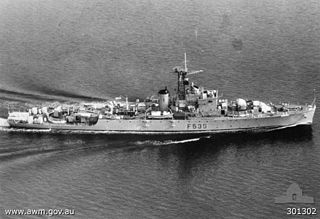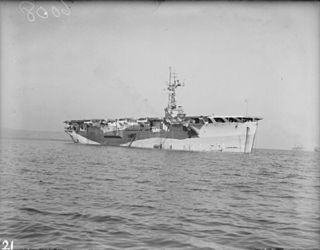
HMS Egret was a sloop of the British Royal Navy, the lead ship of her class. She was built by J. Samuel White at Cowes, Isle of Wight, was launched on 31 May 1938, and entered service on 11 November that year. Egret served as a convoy escort with the Western Approaches Command from 1940 until her loss in August 1943: She was on anti-submarine patrol in the Bay of Biscay when she was sunk by a guided missile in combat, the first ship to be lost in this manner.

HMAS Shoalhaven (K535/M535/F535), named for the Shoalhaven River in New South Wales, was a modified River-class frigate of the Royal Australian Navy. She was laid down by Walkers at Maryborough on 18 December 1943, launched on 14 December 1944 by Senator Dorothy Tangney and commissioned at Urangan Pier in Hervey Bay in Queensland on 2 May 1946. Her first commander was Commander Rodney Rhoades.

Operation Hurricane was the first test of a British atomic device. A plutonium implosion device was detonated on 3 October 1952 in Main Bay, Trimouille Island, in the Montebello Islands in Western Australia. With the success of Operation Hurricane, Britain became the third nuclear power, after the United States and the Soviet Union.
Two ships of the Royal Navy have borne the name HMS Plym, after the River Plym:

HMS Campania was an escort aircraft carrier of the Royal Navy that saw service during the Second World War. After the war, the ship was used as a floating exhibition hall for the 1951 Festival of Britain and as the command ship for the 1952 Operation Hurricane, the test of the prototype British atomic bomb.

HMS Loch Achanalt was a Loch-class frigate of the Royal Navy that was loaned to and served with the Royal Canadian Navy during World War II. Ordered from Henry Robb, Leith, on 24 July 1942 as a River-class frigate, the order was changed, and ship laid down on 14 September 1943, and launched by Mrs. A.V. Alexander, wife of the First Lord of the Admiralty on 23 March 1944 and completed on 11 August 1944. After the war she was transferred to the Royal New Zealand Navy and renamed Pukaki.

HMS Tortola (K595) was a Colony-class frigate of the United Kingdom that served during World War II. She originally was ordered by the United States Navy as the Tacoma-class patrol frigateUSS Peyton (PF-91) and was transferred to the Royal Navy prior to completion.

HMS Ekins (K552) was a British Captain-class frigate of the Royal Navy that served during World War II. Originally constructed as a United States Navy Buckley class destroyer escort, she served in the Royal Navy from 1943 to 1945.

The second HMS Essington (K353), and the first ship of the name to see service, was a British Captain-class frigate of the Royal Navy in commission during World War II. Originally constructed as a United States Navy Buckley-class destroyer escort, she served in the Royal Navy from 1943 to 1945.

The fourth HMS Spragge (K572) and third ship of the name to enter service was a British Captain-class frigate of the Royal Navy in commission during World War II. Originally constructed as a United States Navy Buckley-class destroyer escort, she served in the Royal Navy from 1944 to 1946.
HMS Goodall (K479) was a British Captain-class frigate of the Royal Navy in commission during World War II. Originally constructed as the United States Navy Evarts-class destroyer escort USS Reybold (DE-275), she served in the Royal Navy from 1943 until her sinking in 1945.
HMS Blencathra (L24) was a Hunt-class destroyer of the Royal Navy in commission from 1940 to 1948. She was a member of the first subgroup of the class, and saw service through most of World War II.

The second HMS Wivern, was a Modified W-class destroyer of the British Royal Navy that saw service in World War II.

HMS Ettrick was a River-class frigate that fought for the Royal Navy and the Royal Canadian Navy during the Second World War. The vessel primarily saw action in the Battle of the Atlantic as a convoy escort. The ship was named for the Ettrick Water in Scotland.

Rear Admiral Arthur David Torlesse, was a Royal Navy officer. He commanded the escort carrier HMS Hunter during the latter part of the Second World War, and the aircraft carrier HMS Triumph during the early months of the Korean War. In 1952, he commanded the task force that supported Operation Hurricane, the first British nuclear weapons test.

HMS Teviot (K222) was a River-class frigate of the Royal Navy (RN) from 1942–1955. She served in convoy defence duties in the North Atlantic and Eastern Fleet during World War II. After the war, she served in the South African Navy as HMSAS Teviot before returning to Royal Navy service after six months. Teviot was built to the RN's specifications as a Group I River-class frigate.
HMS Cuckmere (K299) was a River-class frigate of the Royal Navy (RN) in 1943. Cuckmere was originally to be built for the United States Navy, having been laid down as PG-104, but was transferred to the Royal Navy as part of Lend-Lease and finished to the RN's specifications as a Group II River-class frigate. She was first Royal Navy ship to carry the name Cuckmere.

HMS Lagan (K259) was a River-class frigate of the Royal Navy (RN). Lagan was built to the RN's specifications as a Group II River-class frigate. She served in the North Atlantic during World War II.

HMS Mourne (K261) was a River-class frigate of the Royal Navy (RN). Mourne was built to the RN's specifications as a Group II River-class frigate. She served in the North Atlantic during World War II.
HMS Tweed (K250) was a River-class frigate of the Royal Navy (RN). Tweed was built to the RN's specifications as a Group I River-class frigate, though Tweed was one of the few powered by a turbine engine. She served in the North Atlantic during World War II.
















